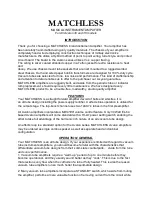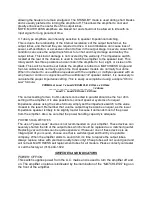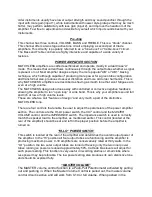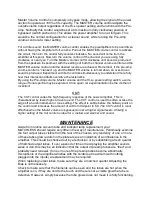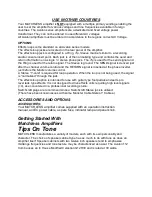
Master Volume Control is completely in bypass mode
, allowing the signal of the power
section to operate at 100% of its capacity.
The MASTER volume control adjusts the
overall
volume
output regardless of the Hi-Lo power setting and functions with the Pre-
Amp. Normally this control would be set at its maximum
(fully
clockwise)
position or
bypassed
(switch pushed in)
. This allows the power amplifier to run at full gain. This
would be the normal configuration for a cleaner sound, while running the Pre-Amp
volume control at a lower setting.
For a
dirtier
sound, the MASTER volume control enables the preamplifiers to be overdriven
without having the amplifier at
full volume
. Pull out the MASTER volume control to activate
the circuit, then turn the control fully counter-clockwise. No sound will come from the
amplifier at this point. Now turn the volume control of the channel you are using fully
clockwise or nearly so. Turn the Master volume control clockwise until sound is produced
from the speakers. Experiment with the settings of both the channel volume control and the
MASTER volume control until the desired results are achieved. Remember, if the pre-amp
volume control
is “cranked” up, and the MASTER volume is turned down, an over-driven
sound is produced. Experiment with both controls simultaneously to understand more fully
how their interaction affects overdrive characteristics.
By using the Pre-Amp volume, Master volume and the Hi-Lo power setting switch, a wide
range of tonal spectra may be explored. Once again, let experimentation be the mother of
invention!
CUT:
The CUT control varies the high frequency response of the power amplifier. This is
characterized by
fewer highs
or
less top end
. The CUT control is used to soften or take the
edge off a harsh instrument or tone setting. The effect is subtle before the halfway point on
the control and increases the amount of cut from midpoint to full.
The CUT
control is most
effective when the Master volume is bypassed or set at higher signal levels. Utilizing a
higher setting of the Cut control is ideal for a mellow and warmer and sound.
MAINTENANCE
Aside from routine vacuum tube and indicator lamp replacement, your
MATCHLESS should require very little in the way of maintenance. Periodically examine
the four output tubes visible from the rear of the chassis. Any tendency of one or more
of these tubes glow
reddish
in the plate area is an indication of an imbalance in the
amplifier. This should be checked out by a technician or by substituting a fresh quartet
of matched output tubes. If over a period of time or hard playing the amplifier sounds
weak
or
dull
, this may be an indication that the output or preamp tubes are
“tired”
and
probably need renewal. If one or more of the preamp tubes become abnormally
microphonic or the amplifier whistles with the controls at maximum (with nothing
plugged into the inputs) a replacement may be required.
When replacing output tubes, make sure they are a matched quartet. Adjusting the
Bias is not necessary.
Check to make sure that the filaments can be seen and the tubes are hot when the
amplifier is on, if they are cold to the touch and there is not a visible glow the tube is
defective. However, simply because the tube glows does not mean it is fully functioning.

